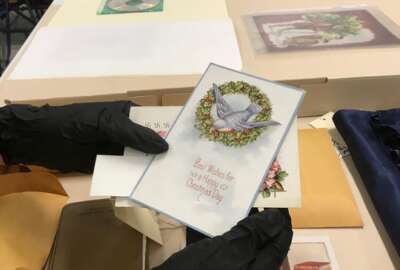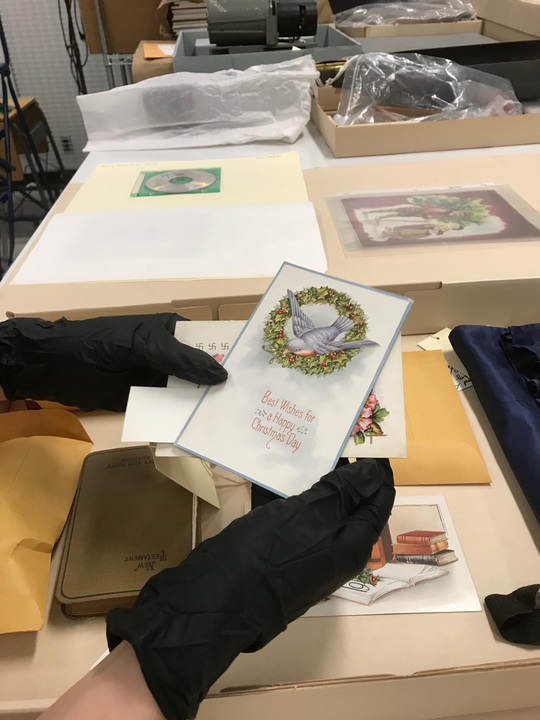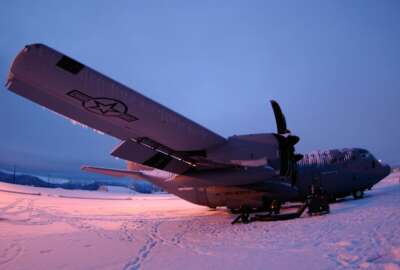
Smithsonian military history curator shows holiday cheer through the eras
Miranda Summers-Lowe, the Smithsonian's newest modern military curator, shares some things that kept troops going during the holidays.
In a drab, fluorescent lit, staff-only room of the National Museum of American History there is a little bit of holiday cheer where you’d least expect it.
A good cheer package from World War I, a beautifully decorated card sent from a World War II service member to a Japanese internment camp and a menu from a Korea War Christmas dinner sit in a room surrounded by military history artifacts.
Miranda Summers-Lowe, the newest modern military curator for armed forces history at the Smithsonian Institution, pulled out some of the things from the Smithsonian’s shelves that kept troops going during the holidays.
“These are pieces from a World War I good cheer bag. These were kind of like care packages. This particular family organization sent out about 45,000 of these bags,” Summers-Lowe said.
The bag held postcards for Christmas and the New Year, lotion for skin, a New Testament Bible, a corncob pipe and a pack of dominoes for entertainment.
“Even in war you still get some downtime so you get a set of dominoes to play with your friends. I feel like that’s one of those objects, you kind of talk to anyone who has been in the service anytime ever and I don’t know how many people will say they learned to play dominoes either in the Army or the Navy. It’s kind of a thing,” Summers-Lowe said.
One holiday item particularly close to Summers-Lowe’s heart is a handmade Christmas card sent from an American soldier of Japanese descent to his family held in a Japanese internment camp in the U.S.
“The draft still affected people who lived in these camps. … They formed this unit, the 442nd combat team. It was an all Japanese-American unit. They train up and they end up in Italy and they end up for the length of time in service and the size of the unit being one of the most decorated, highly awarded units in Army history,” Summers-Lowe.
Finding items like these, preserving them and putting them on display for the public is part of Summers-Lowe’s job as a curator.
But the items have specific meaning to her too. She’s currently in the National Guard and deployed to Iraq in the past.
Summers-Lowe, whose birthday is on Christmas Eve, said during her first deployment she was nervous about being away from home for the holidays, but Christmas ended up being a joyous day.
Her friends made her a cake out of Twinkies. For Christmas, her and her friends got a special gift from everyone in her Black Hawk company.
“Everyone was completely shock that each person had a one gift. I think it was really one of the best Christmases I ever had. We were all away from home, but we were in it together. Everyone had been a little surprised that morning and as we finished opening up our gifts and he were heading to the chow hall this Humvee. … These Marines had decorated it with lights and were driving it around base with the Christmas lights on, blaring Christmas music and dancing in the back. It was such a happy moment,” Summers-Lowe said.
Now as a curator of military history, she is trying to help the public and service members like her learn more about the nation’s fighting force.
“I focus on the all-volunteer force so I’m really looking at 1973 on. That is always going to be complicated because it’s still happening. We are still rotating people into Iraq and Afghanistan and other parts of the Middle East. A lot of what I try to look at is what is it that really captures that experience and to an extent what is fleeting? I’m less worried that we will be able to go back and get a Humvee in 50 years. Those are fairly durable objects. But now people use email instead of letters and if you’re trying to get somebody’s experience the time to do it is now. As I’m starting to plan what I’m collecting I’m looking at lot more at the things I think will go away the fastest,” Summers-Lowe said.
Summers-Lowe said right now she’s working on the World War I centennial exhibit. The D-Day 75th anniversary is coming up, where she’ll be collecting items.
“I would like to put together more on this continuum between the veteran experience and the military experience. We’re more at a point in time where that line is now as clean as it used to be. It’s not the end of World War II where all the troops come home and they join a [Veterans of Foreign Wars] post and they all move to the suburbs. We’re looking at more of this spectrum of a very small, but a mighty group of population of veterans that are going in and out of active duty and increasingly in the Guard and Reserve,” Summers-Lowe said.
Copyright © 2024 Federal News Network. All rights reserved. This website is not intended for users located within the European Economic Area.
Scott Maucione is a defense reporter for Federal News Network and reports on human capital, workforce and the Defense Department at-large.
Follow @smaucioneWFED







